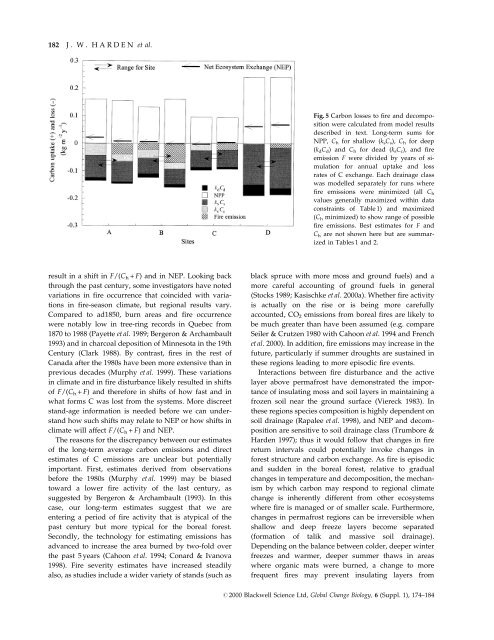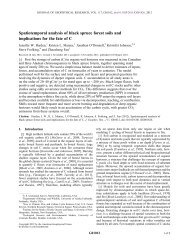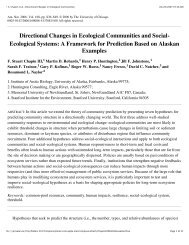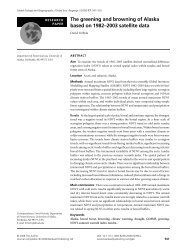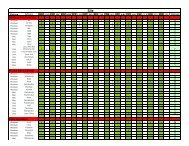Harden, J.W., S.E. Trumbore, B.J. Stocks, A. Hirsh, S.T. Gower, K.P. ...
Harden, J.W., S.E. Trumbore, B.J. Stocks, A. Hirsh, S.T. Gower, K.P. ...
Harden, J.W., S.E. Trumbore, B.J. Stocks, A. Hirsh, S.T. Gower, K.P. ...
- No tags were found...
You also want an ePaper? Increase the reach of your titles
YUMPU automatically turns print PDFs into web optimized ePapers that Google loves.
182 J . W . H A R D E N et al.Fig. 5 Carbon losses to ®re and decompositionwere calculated from model resultsdescribed in text. Long-term sums forNPP, C h for shallow (k s C s ), C h for deep(k d C d ) and C h for dead (k s C c ), and ®reemission F were divided by years of simulationfor annual uptake and lossrates of C exchange. Each drainage classwas modelled separately for runs where®re emissions were minimized (all C hvalues generally maximized within dataconstraints of Table 1) and maximized(C h minimized) to show range of possible®re emissions. Best estimates for F andC h are not shown here but are summarizedin Tables 1 and 2.result in a shift in F/(C h + F) and in NEP. Looking backthrough the past century, some investigators have notedvariations in ®re occurrence that coincided with variationsin ®re-season climate, but regional results vary.Compared to ad1850, burn areas and ®re occurrencewere notably low in tree-ring records in Quebec from1870 to 1988 (Payette et al. 1989; Bergeron & Archambault1993) and in charcoal deposition of Minnesota in the 19thCentury (Clark 1988). By contrast, ®res in the rest ofCanada after the 1980s have been more extensive than inprevious decades (Murphy et al. 1999). These variationsin climate and in ®re disturbance likely resulted in shiftsof F/(C h + F) and therefore in shifts of how fast and inwhat forms C was lost from the systems. More discreetstand-age information is needed before we can understandhow such shifts may relate to NEP or how shifts inclimate will affect F/(C h + F) and NEP.The reasons for the discrepancy between our estimatesof the long-term average carbon emissions and directestimates of C emissions are unclear but potentiallyimportant. First, estimates derived from observationsbefore the 1980s (Murphy et al. 1999) may be biasedtoward a lower ®re activity of the last century, assuggested by Bergeron & Archambault (1993). In thiscase, our long-term estimates suggest that we areentering a period of ®re activity that is atypical of thepast century but more typical for the boreal forest.Secondly, the technology for estimating emissions hasadvanced to increase the area burned by two-fold overthe past 5 years (Cahoon et al. 1994; Conard & Ivanova1998). Fire severity estimates have increased steadilyalso, as studies include a wider variety of stands (such asblack spruce with more moss and ground fuels) and amore careful accounting of ground fuels in general(<strong>Stocks</strong> 1989; Kasischke et al. 2000a). Whether ®re activityis actually on the rise or is being more carefullyaccounted, CO 2 emissions from boreal ®res are likely tobe much greater than have been assumed (e.g. compareSeiler & Crutzen 1980 with Cahoon et al. 1994 and Frenchet al. 2000). In addition, ®re emissions may increase in thefuture, particularly if summer droughts are sustained inthese regions leading to more episodic ®re events.Interactions between ®re disturbance and the activelayer above permafrost have demonstrated the importanceof insulating moss and soil layers in maintaining afrozen soil near the ground surface (Viereck 1983). Inthese regions species composition is highly dependent onsoil drainage (Rapalee et al. 1998), and NEP and decompositionare sensitive to soil drainage class (<strong>Trumbore</strong> &<strong>Harden</strong> 1997); thus it would follow that changes in ®rereturn intervals could potentially invoke changes inforest structure and carbon exchange. As ®re is episodicand sudden in the boreal forest, relative to gradualchanges in temperature and decomposition, the mechanismby which carbon may respond to regional climatechange is inherently different from other ecosystemswhere ®re is managed or of smaller scale. Furthermore,changes in permafrost regions can be irreversible whenshallow and deep freeze layers become separated(formation of talik and massive soil drainage).Depending on the balance between colder, deeper winterfreezes and warmer, deeper summer thaws in areaswhere organic mats were burned, a change to morefrequent ®res may prevent insulating layers from# 2000 Blackwell Science Ltd, Global Change Biology, 6 (Suppl. 1), 174±184


